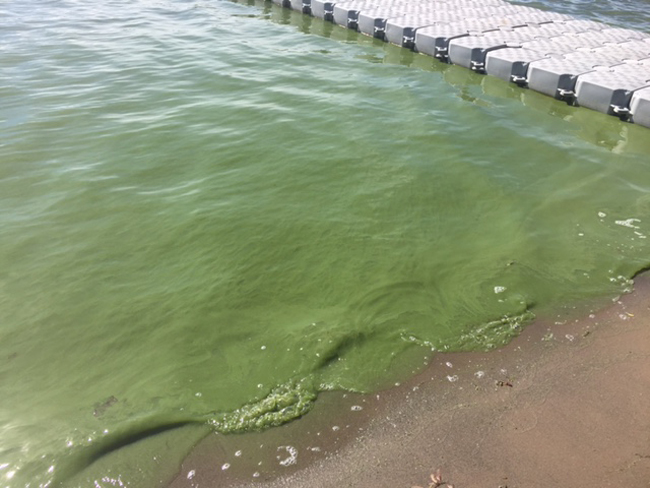
Harmful Algal Blooms change the appearance of water, often resulting in green coloration and limited water clarity. Credit: Gregory L. Boyer.
— By Rural Futures, Spring 2018
Washington, DC, June 19, 2018 - Blue-green algae, or cyanobacteria, have found sanctuary in the calm lakes and ponds of New York and wreak havoc on native flora and fauna. These concentrations of bacteria, or blooms, often appear in warm, nutrient-rich waters that have high concentrations of phosphorus and nitrogen.
Blue-green algae can be identified by its slimy texture, appearing in floating mats of green, blue-green, yellow, brown, or red. The bacteria is often found in dense colonies at the surface of waterways, giving off the appearance of spilled paint.
Large colonies of blue-green algae can block sunlight from permeating the surface, impeding plant growth, and causing stagnation. This algae is can also be harmful to fish and other aquatic species, potentially leading to fish deaths if cyanobacteria populations are high.
Blue-green algae not only comes with an unpleasant presence, but can also cause serious health issues. Humans, pets, and livestock should avoid contact with water containing these algal blooms, as they may contain harmful toxins that can cause a variety of skin irritations, as well as nausea and vomiting.
Jesse Lepak, Fisheries and Ecosystem Health Specialist at New York Sea Grant, encourages people to be vigilant when participating in recreational activities to prevent exposure to HAB’s, and report these sightings.
“The two things that people should do when they suspect a HAB is avoid any contact with the water, and report the bloom to the proper authority,” said Lepak.
In order to limit your own exposure to blue-green algae, avoid swimming in waters that you suspect are experiencing HABs and keep your pets away from those waters as well, as consumption of the water or exposure can be harmful.
“Dogs can be attracted to the odors that the HAB’s emit, and exposure can be high when they clean their fur or drink contaminated water, so they can be particularly at risk,” said Lepak.
“It is best for people and pets to avoid water contaminated with HAB’s until the water is properly tested,” said Jesse. “These measures are necessary when trying to prevent exposure.”
Suspect algal blooms can be reported to the New York State Department of Environmental Conservation (pdf). Email the completed form and, if possible, attach digital photos (close-up and landscape to show extent and location) of the suspected bloom to HABsInfo@dec.ny.gov.
For more information about HAB’s, and what you can do to help prevent their spread, please visit www.nyseagrant.org/habs.
More Info: New York Sea Grant
New York Sea Grant (NYSG), a cooperative program of Cornell University
and the State University of New York (SUNY), is one of 33 university-based
programs under the National Oceanic and Atmospheric Administration’s
National Sea Grant College Program.
Since 1971, NYSG has represented a statewide network of integrated
research, education and extension services promoting coastal community
economic vitality, environmental sustainability and citizen awareness
and understanding about the State’s marine and Great Lakes resources.
Through NYSG’s efforts, the combined talents of university scientists
and extension specialists help develop and transfer science-based
information to many coastal user groups—businesses and industries,
federal, state and local government decision-makers and agency managers,
educators, the media and the interested public.
The program maintains Great Lakes offices at Cornell University, SUNY
Buffalo, SUNY Oswego and the Wayne County Cooperative Extension office
in Newark. In the State's marine waters, NYSG has offices at Stony Brook
University in Long Island, Brooklyn College and Cornell Cooperative
Extension in NYC and Kingston in the Hudson Valley.
For updates on Sea Grant activities: www.nyseagrant.org has RSS, Facebook, Twitter, and YouTube links. NYSG offers a free e-list sign up via www.nyseagrant.org/nycoastlines for its flagship publication, NY Coastlines/Currents, which is published quarterly. Our program also produces an occasional e-newsletter,"NOAA Sea Grant's Social Media Review," via its blog, www.nyseagrant.org/blog.